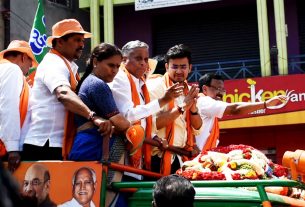Sewage and industrial waste flowing into Vrishabhavathi in the city is haunting the villagers near Bidadi. Clogged plumbing, ruined water heaters add to the woes of health problems such as skin rashes and hair fall.
Ramanagara: High saline and mineral content in groundwater is clogging plumbing and harming household appliances such as solar water heaters and washing machines in villages surrounding the Vrishabhavathi reservoir, near Bidadi.
“If we don’t scrub the inside surfaces of water heaters every day, a thick layer of crystallized salt starts to form,” said Laxmi, a homemaker from Abbanakuppe. It’s the same story with water storage tanks. It’s very corrosive and leaves a white-ish layer in the tanks which is hard to remove.”
Saraswathamma, another homemaker said that their solar water heater stopped working within four years of installation despite a seven-year warranty. And the company refused to reimburse her citing the “hardness” of the water.
Hardness is the measure of dissolved solids in the water, such as salts and minerals. Measured with a TDS (Total Dissolved Solids) meter which estimates the TDS by measuring the water’s conductivity. The ideal TDS is around 100mg/litre, with anything more than 400mg/litre being considered unfit for human consumption.
Rajesh (name changed), a sales and service person for Supreme—a solar water heater company—said that among the villages surrounding the Vrishabhavathi reservoir area, the TDS levels were above 1200mg/litre on average. And often when a new solar heater is installed, he recommends people to have a dedicated water softener installed. But due to the cost, most choose not to.
The Vrishabhavathi river–once the pristine source of freshwater to Bengaluru–drains into the Vrishabhavathi reservoir near Byramangala in Bidadi taluk, Ramanagara District. The reservoir was built decades ago to supply water for agriculture in the surrounding villages. Today, the river is highly polluted with industrial waste and sewage and often its waters turn shades of yellow and purple.
Despite being infamously known as Kengeri Mori (Gutter) among the locals—due to the foul odour and toxic froth it emanates—farmers in more than two dozen villages across Bengaluru rural and Ramanagara districts continue to rely on its waters.
In 2018, the government set up a tertiary sewage treatment plant near Kengeri in south Bengaluru to filter the river’s waters. Another plant is in construction near the Vrishabhavathi reservoir’s backwaters. This new filtration facility is being built to supply farmers of a dozen nearby villages with ‘clean’ water.
Early this year Deputy Chief Minister Dr CN Ashwath Narayan asked the officials to treat the sewage with “advanced technology”. But according to the government, this sewage treatment plant is supposed to only filter a portion of the water coming in and will be channelled into a separate canal. The residents of the nearby villages say they want the government to filter all of the water coming into the reservoir and come up with a permanent solution to reduce the polluted water coming in.
Richa, a hydrologist at Acwadam, a water conservation NGO, said that it’s challenging to assess what is causing the groundwater contamination without on the ground tests and studies as each aquifer is unique and may get its water from multiple sources. However, given that the Vrishabhavathi reservoir received millions of litres of untreated sewage for decades, it’s possible that it may be the prime source of water table contamination in the region.
“Given that the region has seen overutilization of groundwater with borewells reaching depths of 600-1200 on average, the water naturally tends to be harder as it accumulates more minerals while travelling to the aquifer,” she said. “But we also cannot dismiss the role of sewage and untreated chemicals contaminating the groundwater. Hence, the authorities should focus on proper studies to assess the situation on the ground and promote long term solutions such as groundwater harvesting, instead of coming up with stop gap measures for the short-term.”










Good one yo!
Great story.
Good work dude!
Nice story bro!
Great work!
The details are so clear that I can imagine the reality of that place. I Hope for the government to take appropriate actions.